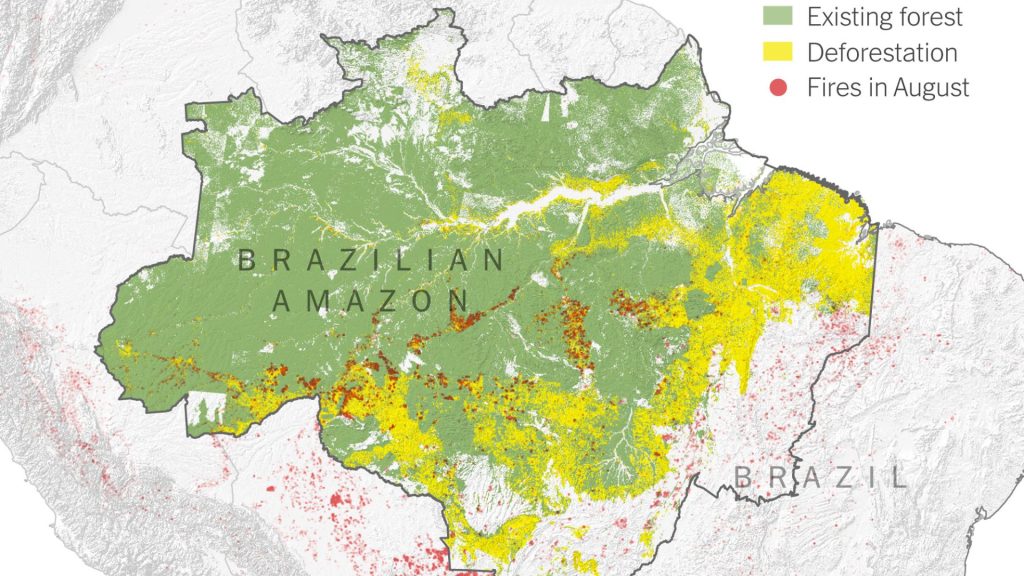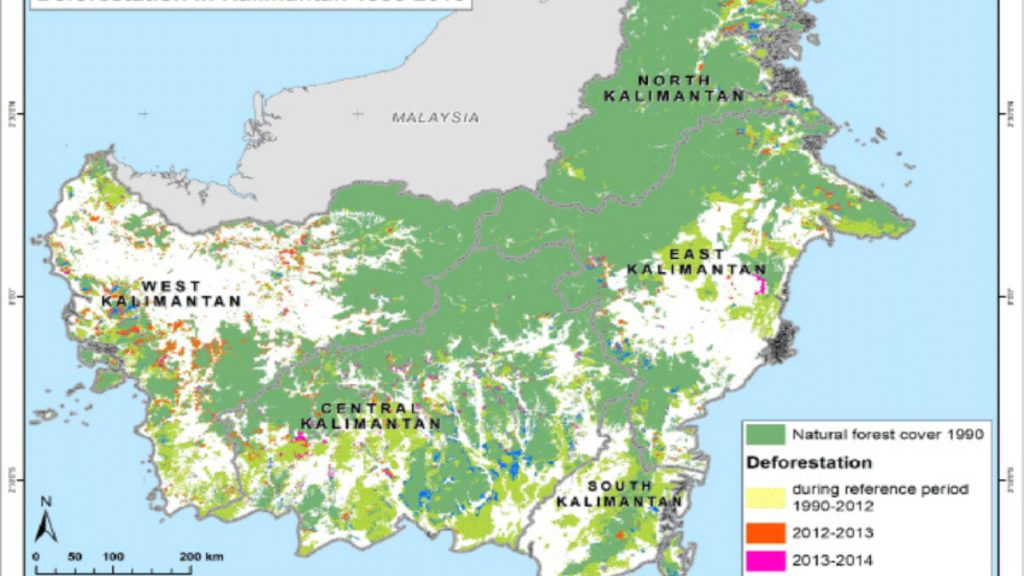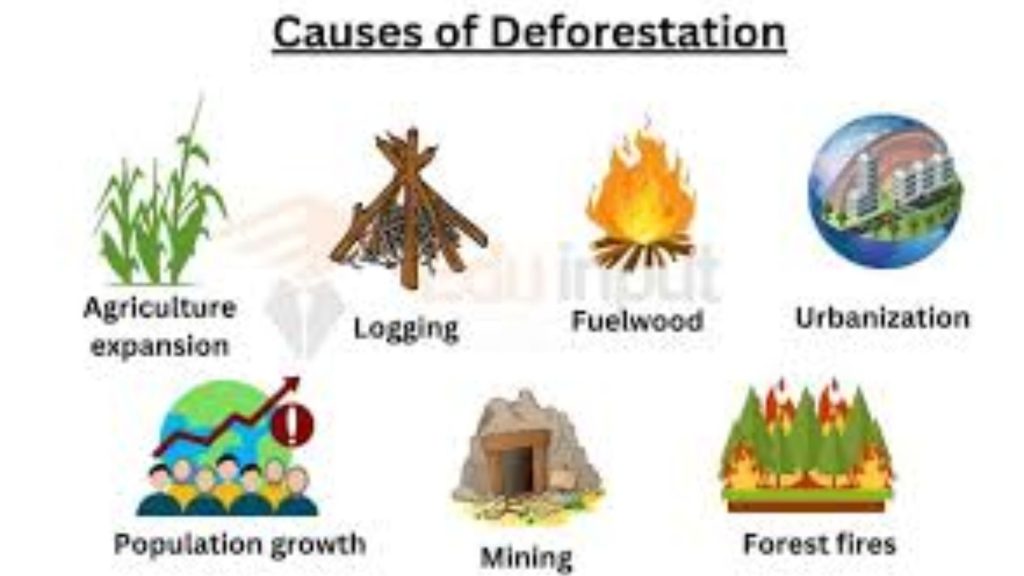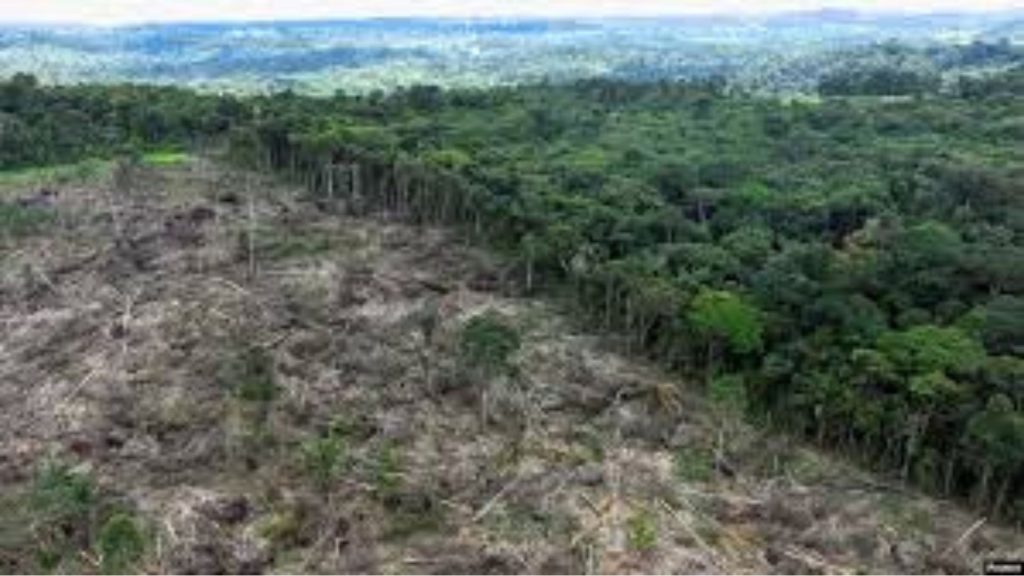The importance of trees in maintaining ecological balance is undeniable, and their removal leads to devastating environmental impacts.
The destruction of the ‘Lungs of our Planet Earth’—the Brazilian Amazon forests—poses a significant threat to the planet’s ecosystem.
As forests like the Amazon play a vital role in absorbing carbon dioxide and releasing oxygen, their depletion due to deforestation is a catastrophic loss.
What is Deforestation?
Deforestation, consequently, is the large-scale clearance of forest land and trees to make way for agriculture, construction, mining, and various other anthropogenic activities in order to sustain the demands of a growing human population.
Forests are our lifeline for food, minerals, timber, and home to Earth’s biodiversity. Historically, forests have provided us with necessities for survival for centuries; however, now humans are exploiting these resources for selfish reasons.
As per statistics, since the 1990s, 420 million hectares of forests have been lost through land conversion for other uses. Consequently, awareness of deforestation’s impact on climate change has led to a decrease in the rate of deforestation in the past three decades. Specifically, between 2015 and 2020, the rate of deforestation has decreased to 10 million hectares per year from 16 million hectares per year in the 1990s. (Source: https://www.fao.org).
Examples of Deforestation
The impact of deforestation is universal. Consequently, developing nations undergoing rapid deforestation will have a large impact on climate change globally. To illustrate, we will now examine some examples of countries that have experienced the most significant effects of deforestation over the past two decades:
The Brazilian Amazon Forests, South America- 1,695,700 hectares of deforestation

Map showing extent of deforestation in Amazon Rainforests, Brazil
They are called ‘The Lung of Planet Earth’ due to their ability to absorb 25% of the world’s carbon dioxide emission and release 6% of the world’s oxygen into the atmosphere. These rainforests have seen the highest amount of deforestation 1,695,700 hectares of forest were lost between 2015-2020. This is due to the impact of climate change affecting rainfall and temperature leading to slower growth of forestry. Forest fires have also been a contributing factor to the depletion of forests. (Source: Our World in data)
India, Asia- 668,400 hectares of deforestation
Consequently, India has seen the most rapid rate of deforestation and lost 2,84,400 hectares of forest land. The increasing population and rapid urbanization, along with meeting their agricultural demands, have led to the cutting down of trees. (Source: Our World in Data)
Indonesia, Asia- 650,000 hectares of deforestation

Map showing deforested land in Borneo Forests, Malaysia
The loss of forestry in Indonesia is due to their palm oil exports. Indonesia is the largest exporter of palm oil which is used in various food products. Palm oil cultivation requires the clearing of large forest lands. (Source: Our World in Data)
Causes of Deforestation and the role of trees

Causes of Deforestation are numerous and are mainly contributed by man and rarely by nature
Deforestation is caused by various anthropogenic and natural activities. It is to either meet the increasing demands of a growing population or a result of natural disasters like forest fires.
Agricultural Expansion
- Large-scale Farming: Specifically, in Brazil, the expansion of soy farming has been a significant driver of deforestation. Consequently, between 2001 and 2018, approximately 20% of the country’s soy expansion occurred at the expense of native vegetation. (Source: World Wild Life).
- Cattle Ranching: For instance, in the Brazilian Amazon, cattle ranching is responsible for about 80% of deforestation. Consequently, over the past 50 years, approximately 17% of the forest has been cleared, much of it for cattle pasture. (Source: Mongabay).
- Slash-and-Burn Techniques: In countries like Madagascar, slash-and-burn agriculture, or “tavy,” is a common practice among small-scale farmers. This method is responsible for the loss of 90% of Madagascar’s original forests (Source: Rainforest Alliance).
Logging
- Timber Extraction: Countries like Indonesia and Malaysia have extensive legal and illegal logging timber trees operations. Illegal logging accounts for up to 70% of logging activities in these regions, contributing significantly to deforestation (Source: World Wild Life).
- Pulp and Paper Production: In Canada and Russia, large areas of boreal forest trees are cleared for pulp and paper production. Canada alone harvests around 140,000 hectares of forest annually for this industry (Source: Greenpeace).
- Energy Needs: In many African countries, up to 80% of the population relies on trees for wood for cooking and heating. This dependence leads to significant deforestation, with about 4 million hectares of forest lost annually (Source: FAO).
Infrastructure Development
- Urbanization: Cities like Lagos, Nigeria, and Kinshasa, DRC, are expanding rapidly. This urban growth requires the clearing of forests for housing and infrastructure, contributing to deforestation (Source: Uninhabitat).
- Industrial Development: Rapid industrialization has led to significant deforestation. For example, the construction of the Three Gorges Dam resulted in the flooding of forested areas and the relocation of communities, leading to further forest clearance for new settlements (Source: The Gaurdian).
- Transportation Networks: The construction of the Trans-Amazonian Highway has facilitated access to previously remote forest areas, leading to increased logging and agricultural expansion (Source: Nature).
- Railways and Airports: The development of transportation infrastructure, including new railways and airports, has led to significant deforestation, particularly in Kalimantan and Sumatra (Source: Mongabay).
- Mining: In the Amazon, illegal gold mining has led to the deforestation of vast areas. Between 2001 and 2013, over 50,000 hectares of forest were lost to gold mining activities (Source: Nature).
- Oil and Gas Exploration: Oil extraction in the Niger Delta has resulted in extensive deforestation and environmental degradation. The region has lost significant mangrove forests due to oil spills and land clearance (Source: Amnesty).
- Fires: The use of fire for land clearing in Indonesia has led to uncontrolled wildfires, causing extensive forest loss. In 2015, fires in Indonesia destroyed over 2 million hectares of forest (Source: World Wild Life).
- Climate and Weather: Droughts and extreme heat in California, exacerbated by climate change, have increased the frequency and intensity of forest fires, leading to significant deforestation (Source: Fire).
- Temperature and Rainfall Patterns: Climate change is making the Amazon more vulnerable to pests and diseases, which, combined with higher temperatures and changing rainfall patterns, is contributing to increased deforestation (Source: Global Forest Watch).
- Global Population Growth: The growing human population increases the demand for land for agriculture, housing, and infrastructure, leading to deforestation. By 2050, it is estimated that an additional 120 million hectares of natural habitats will be converted to cropland (Source: FAO).
Economic Factors
- Economic Factors: In Haiti, severe poverty drives deforestation as people clear forests for agriculture and fuelwood. The country has lost 98% of its original forest cover (Source: Global Forest Atlas).
- Market Demand: The global demand for timber incentivizes deforestation in countries like Brazil, Indonesia, and the Democratic Republic of the Congo. Illegal logging activities are often driven by this high market demand (Source: Chatham House).
Policy and Governance Issues
- Illegal Logging: Inadequate enforcement of environmental regulations in countries like Brazil allows illegal logging to flourish. It is estimated that up to 80% of logging in the Brazilian Amazon is illegal (Source: World Wild Life).
- Corruption: Corruption within governments in Southeast Asian countries leads to the granting of land concessions for agriculture or logging without proper oversight. This practice contributes significantly to deforestation (Source: Transparency).
Impacts of Deforestation on trees and biodiversity.

Image showing land cleared for Agricultural purposes
Forests, being the source of life and habitat for various species, have a great impact on biodiversity, tribal communities, and even climate. Consequently, the preservation of forests has become a major goal for climate action.
Environmental Impacts
- Habitat Destruction: Forests are home to over 80% of terrestrial animals and plants. Deforestation leads to the destruction of these habitats, threatening the survival of many species and leading to reduced biodiversity (Source: World Wild Life).
- Species Extinction: The International Union for Conservation of Nature (IUCN) estimates that about 28,000 species are currently threatened with extinction due to habitat loss from deforestation (Source: IUCN).
Soil Degradation
- Soil Erosion: Trees and vegetation help to hold the soil together. When they are removed, the soil becomes more susceptible to erosion by wind and water (Source: FAO).
- Loss of Nutrients: Without the protective cover of forest trees, soil loses its fertility quickly due to nutrient leaching (Source: Science Direct).
- Flooding: Mangrove deforestation, such as along the banks of the Mithi River in Mumbai, was a major cause of intense flooding on July 26th, 2005. Preserving mangroves could have mitigated this disaster (Source: Current Science).
How trees contribute to Water Cycle Disruption
- Water Cycle Role: Trees play a crucial role in the water cycle by returning water vapor to the atmosphere through transpiration. Deforestation can disrupt local and global rainfall patterns (Source: NASA).
- Increased Flooding and Droughts: Forests absorb rainfall, reducing runoff. Their removal can lead to more frequent and severe floods and droughts (Source: World Wild Life).
Climate Impacts
- Increased Greenhouse Gas Emissions: Forests act as carbon sinks, absorbing carbon dioxide from the atmosphere. However, deforestation releases stored carbon back into the atmosphere, contributing to greenhouse gas emissions. (Source: Global Forest Watch).
- Climate Change Acceleration: The World Resources Institute reports that deforestation accounts for about 10% of global carbon emissions, thereby exacerbating global warming. (Source: WRI).
- Temperature Changes: Forests help to regulate temperatures. Their removal can lead to local temperature increases, affecting weather patterns and potentially leading to more extreme weather events (Source: World Wild Life).
Social and Economic Impacts
- Indigenous Displacement: Many indigenous peoples rely on forests for their homes, culture, and livelihoods. Deforestation displaces these communities, leading to loss of cultural heritage and traditional knowledge (Source: CIFOR).
- Loss of Livelihoods: Forest-dependent communities often lose their sources of food, medicine, and income due to deforestation (Source: FAO).
Economic Costs
- Reduced Ecosystem Services: Forests provide essential ecosystem services such as pollination, water purification, and climate regulation. Their loss can have significant economic costs (Source: Nature).
- Economic Stability: While deforestation can bring short-term economic gains through timber sales and land for agriculture, it often undermines long-term sustainability and economic stability (Source: World Bank).
Health Impacts
- Air and Water Pollution: Deforestation often leads to increased pollution of air and water sources, impacting human health. The burning of forested areas contributes to air pollution, while the lack of trees can lead to contamination of water bodies (Source: EPA).
- Disease Spread: The disruption of forest ecosystems can increase the spread of diseases. For example, deforestation in tropical regions links to the rise in malaria cases, as mosquito habitats are altered. (Source: WHO).
Ocean Health
- Marine Biodiversity: Deforestation affects the health of oceans by increasing the runoff of sediments and pollutants, which can damage coral reefs and marine biodiversity (Source: Ocean Service).
- Biodiversity Hotspots: Tropical rainforests, which are particularly vulnerable to deforestation, are biodiversity hotspots. Their destruction has global implications for conservation efforts (Source: Conservation).
Food Security
- Agricultural Impact: Although the need for agricultural land often drives deforestation, it degrades soil quality and alters local climates, undermining long-term food security by making these areas less suitable for agriculture. (Source: FAO).
Deforestation has had a devastating impact on the lives of humans and animals. Moreover, it has been a major contributor to climate change, leading to the loss of carbon sinks, increased global warming, and loss of biodiversity. Consequently, the awareness towards preserving our forests has led to the Earth5R Plantation program. The objective is to organize plantation events for individuals, corporations, or even special occasions but more importantly educate communities about the importance of restoring our forests and saving our saviors- The Trees!
Earth5R Partnership
Companies interested in partnering with Earth5R in River Cleanups, Beach Cleanups or Lake cleanup Programs can write to us at community@earth5r.org or Call us on 9920045587.
Please give us ample time to design events & projects as per requirements.
At Earth5R, we support you every step of the way, from planning and building communities to selecting volunteers, executing projects, and managing them.
We also handle event reporting and management on our app and social media platforms.
We help companies improve their ESG ranking and portfolio by making a real impact through participation in national environmental programs.



